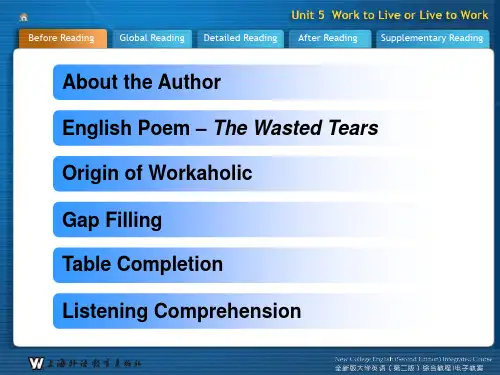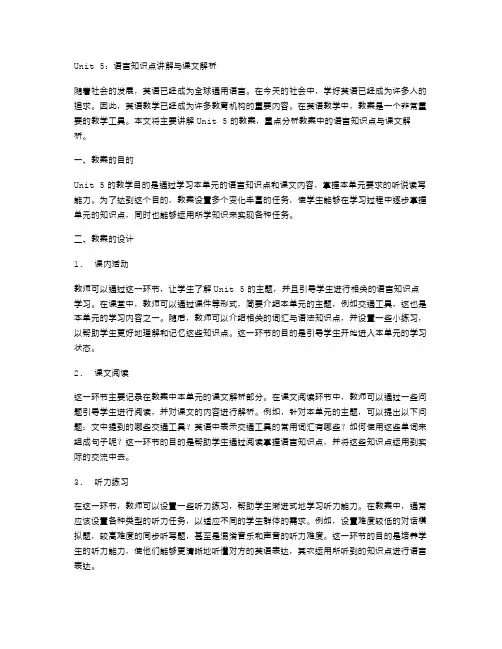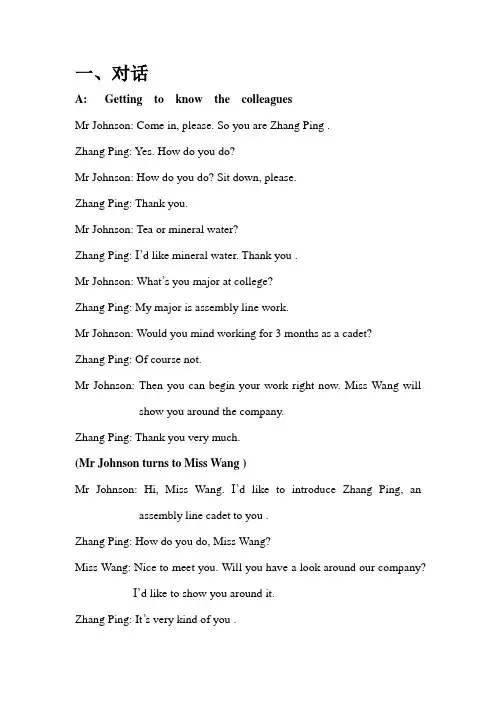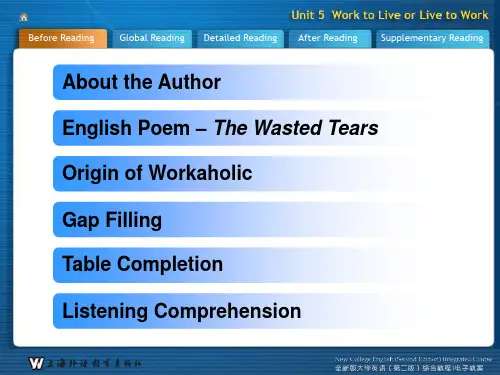英语专升本综合教程unit5教案
- 格式:doc
- 大小:95.00 KB
- 文档页数:11







Unit 5:语言知识点讲解与课文解析随着社会的发展,英语已经成为全球通用语言。
在今天的社会中,学好英语已经成为许多人的追求。
因此,英语教学已经成为许多教育机构的重要内容。
在英语教学中,教案是一个非常重要的教学工具。
本文将主要讲解Unit 5的教案,重点分析教案中的语言知识点与课文解析。
一、教案的目的Unit 5的教学目的是通过学习本单元的语言知识点和课文内容,掌握本单元要求的听说读写能力。
为了达到这个目的,教案设置多个变化丰富的任务,使学生能够在学习过程中逐步掌握单元的知识点,同时也能够运用所学知识来实现各种任务。
二、教案的设计1.课内活动教师可以通过这一环节,让学生了解Unit 5的主题,并且引导学生进行相关的语言知识点学习。
在课堂中,教师可以通过课件等形式,简要介绍本单元的主题,例如交通工具,这也是本单元的学习内容之一。
随后,教师可以介绍相关的词汇与语法知识点,并设置一些小练习,以帮助学生更好地理解和记忆这些知识点。
这一环节的目的是引导学生开始进入本单元的学习状态。
2.课文阅读这一环节主要记录在教案中本单元的课文解析部分。
在课文阅读环节中,教师可以通过一些问题引导学生进行阅读,并对课文的内容进行解析。
例如,针对本单元的主题,可以提出以下问题:文中提到的哪些交通工具?英语中表示交通工具的常用词汇有哪些?如何使用这些单词来组成句子呢?这一环节的目的是帮助学生通过阅读掌握语言知识点,并将这些知识点运用到实际的交流中去。
3.听力练习在这一环节,教师可以设置一些听力练习,帮助学生渐进式地学习听力能力。
在教案中,通常应该设置各种类型的听力任务,以适应不同的学生群体的需求。
例如,设置难度较低的对话模拟题,较高难度的同步听写题,甚至是混淆音乐和声音的听力难度。
这一环节的目的是培养学生的听力能力,使他们能够更清晰地听懂对方的英语表达,其次运用所听到的知识点进行语言表达。
4.口语表达在这一环节,教师可以设置一些几人或多人的对话练习,通过通过轮流表达观点,逐步提高学生的口语表达能力。

一、对话A: Getting to know the colleaguesMr Johnson: Come in, please. So you are Zhang Ping .Zhang Ping: Yes. How do you do?Mr Johnson: How do you do? Sit down, please.Zhang Ping: Thank you.Mr Johnson: Tea or mineral water?Zhang Ping: I’d like mineral water. Thank you .Mr Johnson: What’s you major at college?Zhang Ping: My major is assembly line work.Mr Johnson: Would you mind working for 3 months as a cadet?Zhang Ping: Of course not.Mr Johnson: Then you can begin your work right now. Miss Wang will show you around the company.Zhang Ping: Thank you very much.(Mr Johnson turns to Miss Wang )Mr Johnson: Hi, Miss Wang. I’d like to introduce Zhang Ping, an assembly line cadet to you .Zhang Ping: How do you do, Miss Wang?Miss Wang: Nice to meet you. Will you have a look around our company?I’d like to show you around it.Zhang Ping: It’s very kind of you .Miss Wang: This way, please.B. getting to know the companySam: Hi, my name is Sam---Terry: Sam Williams, the new expert on numerical control? Nice to meet you! I’m Terry Fields.Sam: Nice to meet you!Terry: Now, let me show you around. This is our reception area, and our conference room is right over there.Sam: This is a nice office. What’s that?Terry: Why, the break room, of course.Sam: Hmm this isn’t a bad way to learn about the company.Terry: Those are the manger’s offices. Stay away or they’ll make you make.Sam: Hmm, tell me more about the company’s operations.Terry: Sure thing. Here’s brochure telling about our product manufacturing and quality control systems……二、短文My new boss was a bit annoyed when he heard that 1 couldn’t drive the forklift. Indeed, there are lots of basic skills that Andover, Bates, Columbia and Harvard never taught me. But there are moments when I shine. I can read the Latin on every public building we pass. When I began chatting with the truck driver form Quebec in fluent French, myboss’s eyes lit up.三、翻译a. Translate the following sentences chosen form text a into Chinese1.Like thousands last year, I was dismissed form one of those networkcompanies.2.My new boss was a bit annoyed when he heard that 1 couldn’t drivethe forklift.3. When I began chatting with the truck driver form Quebec in fluent French, my boss’s eyes lit up.4. It is as important as the ability to operate Microsoft Office is to the white-collar one.5.In some ways, ours is a clash of cultures.b. Complete the following sentences by translating the into English .1.这座办公大楼面对着公园。



课程名称:大学英语综合教程1授课对象:大学英语一年级学生授课时间:2课时教学目标:1. 学生能够通过阅读、讨论和写作等活动,理解和掌握本单元的主题——家庭与个人价值观。
2. 学生能够运用所学的词汇和语法知识,进行有效的口语和书面表达。
3. 学生能够了解不同文化背景下家庭观念的差异,培养跨文化交际能力。
教学重点:1. 本单元的词汇和语法知识。
2. 家庭与个人价值观的表达和讨论。
教学难点:1. 家庭与个人价值观的深入理解。
2. 跨文化交际中家庭观念的差异分析。
教学过程:第一课时:一、导入新课1. 利用图片或视频展示不同文化背景下家庭的场景,激发学生对家庭话题的兴趣。
2. 提问:家庭在你的生活中扮演着怎样的角色?你如何看待家庭价值观?二、词汇教学1. 通过图片、例句等形式,介绍本单元的词汇,如:family, parent, tradition, respect, responsibility等。
2. 学生分组,进行词汇接龙游戏,巩固所学词汇。
三、阅读教学1. 学生阅读课文,了解文章大意。
2. 教师引导学生分析文章结构,提炼出文章的主旨大意。
3. 学生讨论文章中的观点,表达自己的看法。
四、语法教学1. 介绍本单元的语法知识,如:现在进行时、过去完成时等。
2. 学生通过例句练习,掌握语法知识。
五、课堂小结1. 教师总结本节课所学内容,强调重点和难点。
2. 学生回顾所学词汇和语法知识。
第二课时:一、复习导入1. 回顾上一节课所学内容,检查学生对词汇和语法的掌握情况。
2. 学生进行口语练习,用所学词汇和语法知识描述家庭生活。
二、写作教学1. 学生根据课文内容,撰写一篇关于家庭价值观的短文。
2. 教师指导学生修改作文,注意语法、词汇和表达方式。
三、课堂讨论1. 学生分组讨论,分享自己对家庭价值观的看法。
2. 教师引导学生分析不同文化背景下家庭观念的差异。
四、课堂小结1. 教师总结本节课所学内容,强调家庭价值观的重要性。
英语教案-Unit5教学目标1.学生能够掌握表示“再见”和“问候”的基本英语表达方式。
2.学生能够正确使用目标语言进行口语交际。
3.学生能够根据所学内容,编写简短的英文问候卡片。
教学重点1.礼貌地道地表达问候和再见的英语表达方式。
2.目标语句的正确发音和语调。
教学难点1.学生在真实情境中正确运用所学内容进行口语交际。
2.学生能够写出简短的英文问候卡片,使其有一定的实用性。
教学准备1.教师:多媒体课件、黑板、白板。
2.学生:学习材料、学生课本。
教学过程步骤一:引入新课(15分钟)1.教师通过多媒体课件或黑板展示常见的英语问候用语,如“hello”,“goodbye”,“how are you?”等,引起学生的兴趣和好奇心。
2.教师鼓励学生尝试用目标语言表达一下自己的问候。
步骤二:学习新知(30分钟)1.教师通过多媒体课件或黑板展示目标语句的书写和发音,并进行语音示范。
2.教师逐句解释目标语句的含义和用法,并请学生跟读、模仿。
3.教师引导学生进行口语对话练习,模拟真实情境,例如在商店购物或与朋友交流时的问候。
步骤三:巩固训练(30分钟)1.教师布置小组活动,让学生分成小组,利用所学内容进行问候对话练习。
教师可以提供一些情景,例如在机场、学校、饭店等等。
2.教师巡回辅导,确保学生在小组活动中正确使用目标语言进行交流。
步骤四:拓展活动(30分钟)1.教师鼓励学生创作自己的英文问候卡片。
2.学生可以设计卡片的样式和内容,在卡片上用目标语言表达对朋友、老师、家人等的问候。
3.学生可以轮流给其他同学展示自己设计的卡片,并将问候真诚地表达出来。
教学延伸1.学生可以通过阅读英语杂志、报纸等来扩充自己的英语问候词汇。
2.学生可以多听和模仿英语问候用语的发音,提高口语表达能力。
3.学生可以将学到的英语问候用语运用到日常生活中,例如在与外国友人交流、旅游、参加英语角等场合。
总结本节课我们学习了英语中表示“再见”和“问候”的基本表达方式。
Teaching PlanUnit 5 Travelling abroadReading ----- Keep it up, Xie LeiI. Teaching Aims:1. Enable the students to know the general idea of the text.2. Know about some useful words, expressions and sentence patterns.3. Learn about the advantages and disadvantages of studying abroad.4. Improve students’ abilities of listening, reading and writing.5. Cultivate the students to be adaptable, independent, persevering and enterprising. II. Teaching Important Points:1. Learn about the advantages and disadvantages of studying abroad.2. Improve st udents’ abilities of listening, reading and writing.3. Let the students master the composition pattern.III. Teaching Difficult Points:1. Learn about the advantages and disadvantages of studying abroad.2. Learn to write comparison composition.IV. Teaching aids:Multi-media, learning paper and Bb.V. Teaching Procedures:Step 1. Lead- inShow some vivid and real pictures and tell some advantages of studying abroad. Step 2. Fast ReadingRead the whole passage and finish Ex. I on the learning paper.Step 3. Careful Reading1.Read Paras 1-2 and finish Ex.II-1 on the learning paper.2.Read Paras 3-5 and finish Ex.II-2 on the learning paper.Step 4. ConclusionWe should learn from Xie Lei to be adaptable, independent, persevering and enterprising.Step 5. WritingInstruct the students to write a composition with what they have learned in the text.Step 6. Homework.1. Read the text again loudly;2. Write the composition.Step7. Blackboard DesignUnit 5 Keep it up, Xie LeiI. The Structure of The TextPara.1-2 a brief introductionPara. 3-5 advantages and disadvantagesPara. 6-7 Xie Lei fits in wellII. Key PointsSentence patterns1. It was the first time that she had ever left her motherland.It is the first time that she has left her motherland.I have left my motherland.2. (It is) not just study (that) is difficult.。
Unit Five Following Fashion Teaching Objective 1. Teach Ss some useful words about fashion and guide them in talking about fashion. Through teacher-student interactive class-activities, develop Ss’ability to express correctly the style and trend in the fashion world. 2. Help Ss well understand the two texts and learn to use the important words, phrases and sentence patterns in this unit and complete the text-related exercises correctly. 3. Teach Ss how to write English Ads, and ask them to pay attention to the differences between Chinese Ads and English Ads so that they may not make mistakes in writing English Ads. 4. Help Ss review English word formation (suffixes: -ence / -ance / -ancy / ency) and English grammar (adverbial clauses).
Section A Listening and Speaking Listening Comprehension Part 1 Who designed these fashionable goods Part 2 Who is Coco Chanel Part 3 The story of Coco Chanel. Part 4 A fashion show. Part 5 The meaning of “couturier” in the fashion world. Speaking Practice Sample 1 M: How beautiful are the suits you’re wearing! W: Yeah. They were designed by Coco Chanel, and I’m very happy to have this chance to show them to my audience.
Section B Text Learning Text Coco Chanel Background Information Coco Chanel was born on August 19, 1883 in Saumur, France. Her father was a stallholder and her mother a laundry woman. Her mother died of tuberculosis when she was 12. She was sent to an orphanage for the next 6 years. While in the orphanage the nuns taught her to be a seamstress. When she spent time with relatives they taught her to sew more beautiful things. This started her love for design career. When she left the orphanage she wanted to be a singer. She picked up her nickname “Coco” from the clubs she sung in. “Coco” is short for “Coquette” (kept woman).
She failed to get work as a singer. She met Etienne Balsan and became his mistress. He gave her diamonds, dresses and pearls to show his affection. She worked at a tailoring shop during the day while she was with Balsan. She soon left him and took over his apartment. She had an affair with one of Balsan’s friends, Captin Aruther Edward “boy” Capel. He financed Chanel’s first shops. His style inspired her to create her own look.
In 1910 she became a licensed moodiest and opened a boutique named Chanel Modes. In 1913 she opened another boutique in Deauville where she introduced clothing. In 1915 she again opened another Boutique called Chanel-Biarritz. By 1919 she was a recognized couturiere. In 1922 she introduced her first perfume Chanel No. 5. It became and stayed popular since its birth. During 1925 she met Vera Bate Lombardi. She became Chanel & apos; liaison to a number of royal European families. In 1939 Chanel closed all her shops because it was to her, not a time for fashion, because of the war. She became involved with the Nazi party and in return was arrested, but all charges were dropped. Returning in 1954, she came back to the fashion world. Most of her new collection was not popular. She introduced Pea Jackets and bell bottom pants for women. She was still working until she died in 1971.
Language Point 1. There is no question in the fashion world that the most significant designer of the 20th century world is Coco Chanel. fashion n. the state of being popular 流行式样;时装;时尚;方式
. Jeans are still in fashion. 牛仔裤仍然流行。 Some styles never go out of fashion. 有些式样永远不会过时。 significant a. large or important enough to have an effect or to be noticed
重要的;暗示的;有含义的 . There are no significant differences between the two groups of students. 这两组学生没有明显不同。 It is significant that girls generally do better in examinations than boys. 很明显,女生的考试成绩一般比男生好。 2. As her business grew she became a dressmaker and created her own style in clothing. grow n. 1) to increase in size, number, strength or quality 扩大;增加;增强
. The company profits grew by 5% last year. 去年公司的利润增加了5%。 The family has grown in size recently. 这家人最近添丁进口了。 2) link-verb. to begin to have a particular quality or feeling over a period of time逐渐变得;逐渐成为 . As time went on, he grew more and more impatient. 时间长了,他越来越没有耐心。 The skies grew dark and it began to rain. 天渐渐黑了,又下起雨来。 create v. 1)to make sth. happen or exist 创造;创作
. Scientists disagree about how the universe was created. 科学家对宇宙是怎样形成的有分歧。 Try this new dish created by our head chef. 尝一下这道新菜吧,是我们厨师长的首创。 2)to produce a particular feeling or impression 造成,引起 . The announcement only succeeded in creating confusion. 那通告反而引起混乱。 They’ve painted it red to create a feeling of warmth. 他们把它刷成红色造成一种温暖的感觉。 style n. 1) the particular way in which sth. is done 方式,作风